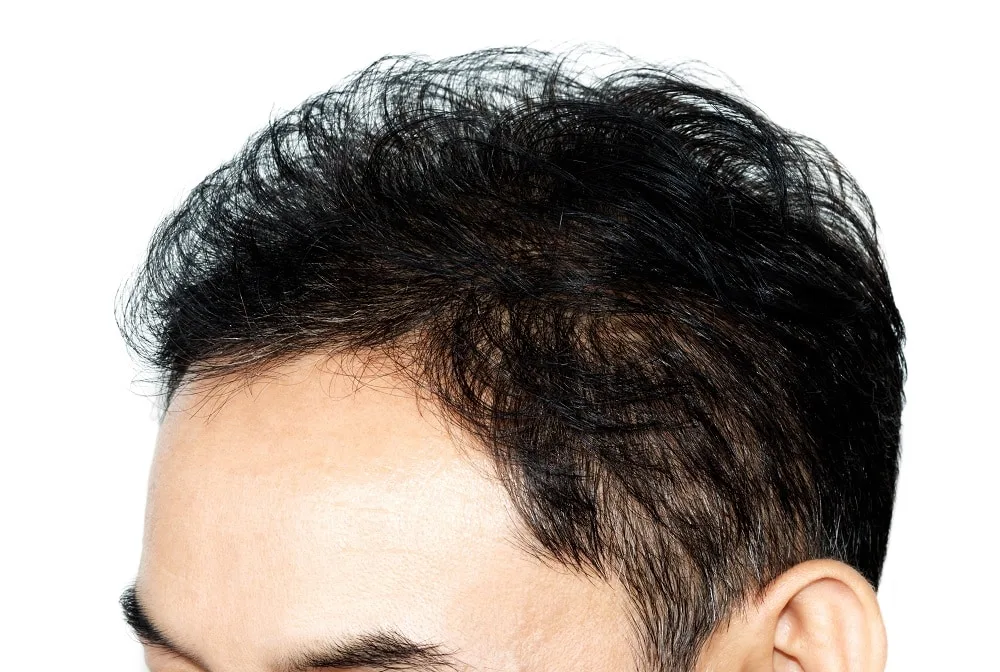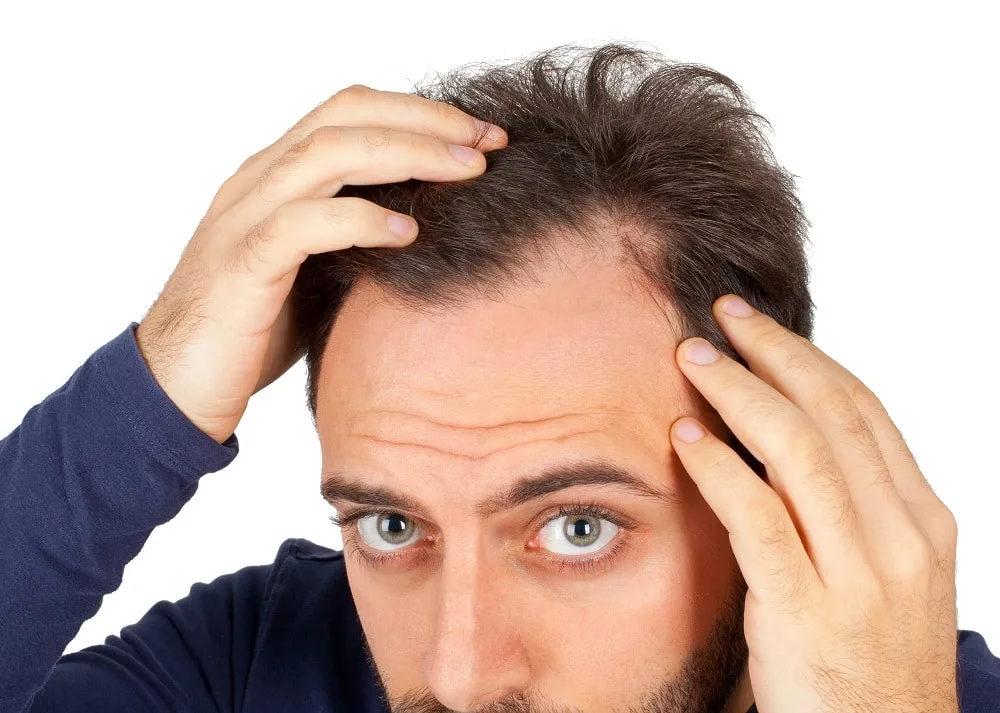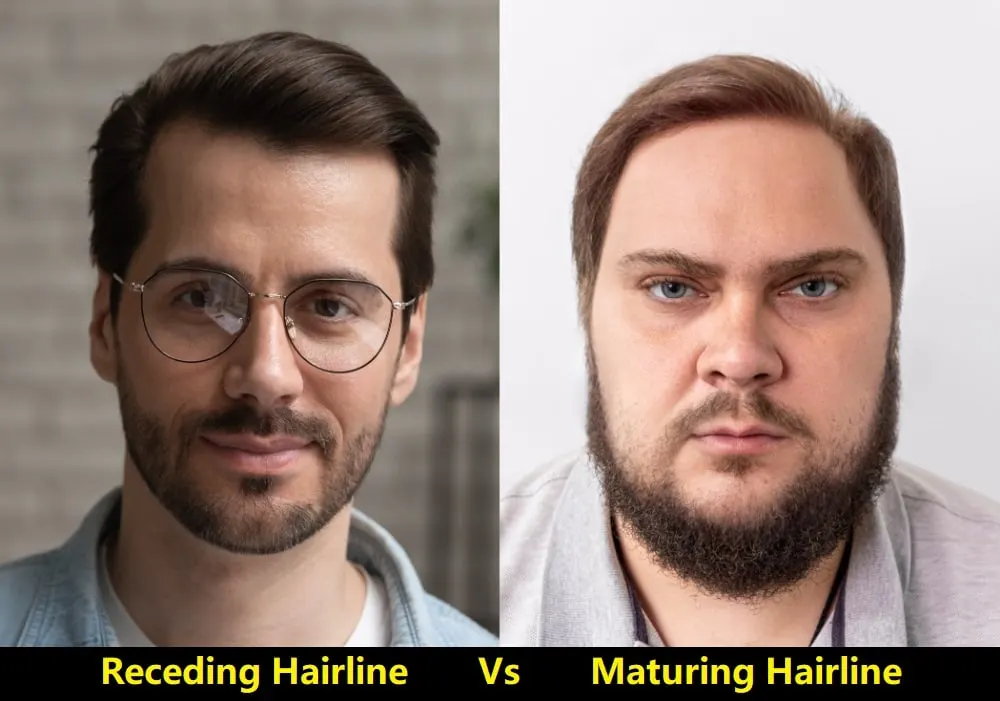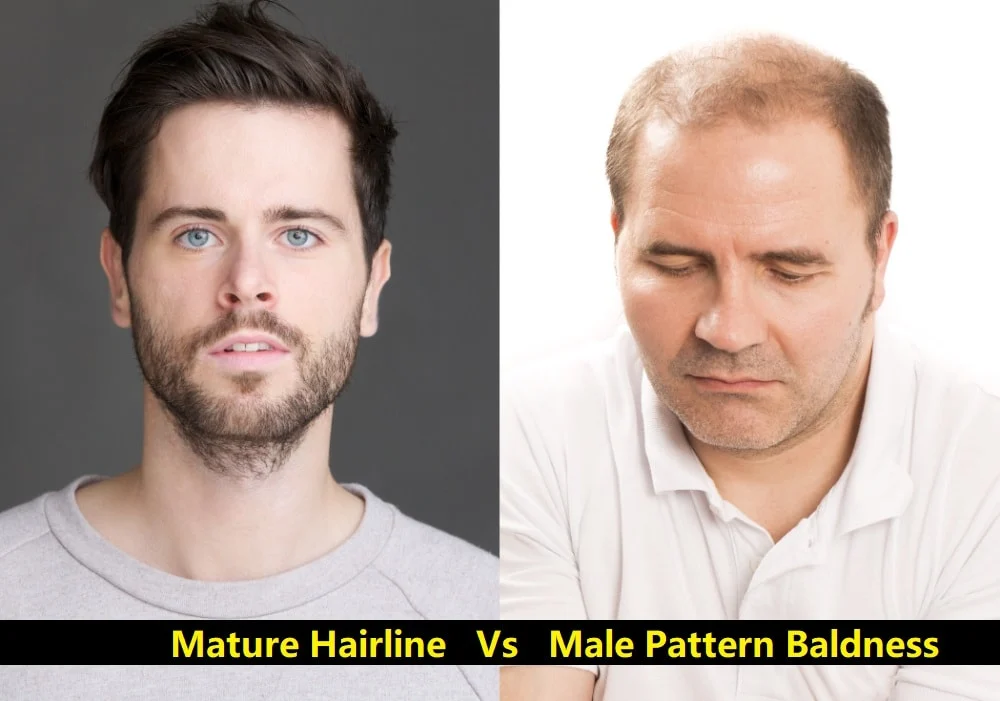Are you worried about your changing hairline? Before you panic, let’s take a look at the signs of maturing hairline vs. receding hairline side-by-side, so you’ll know if you can relax or if this is one thing you need to get worried about.
While fixing your hair, you notice that your hairline has gotten higher and a bit thinner.
As you sit there, a lot of questions pop into your mind.
Am I getting bald?
Am I going to lose all my hair?
We’re going to be honest with you. A change in hairline may mean any of these two things:
- A maturing hairline which is a common sign of aging that happens to everyone, or
- A receding hairline is an early sign of male pattern baldness.
It’s important that you identify which type of hairline you have, so you can know if you can relax or if you should take the necessary steps to prevent or delay hair loss.
So how would you know which is which? Well, there are signs to look for, and that’s what we’ll talk about in this article.
What Is a Mature Hairline?

A mature hairline is a part of the aging process and features a uniform retreat and shifting of the hairline from its original position.
It typically occurs in men, especially between the ages of 17 to 30. There is about an inch or half-inch of movement of the hairline, after which the receding halts.
The process of hairline maturation can be gradual and may take years to develop. Therefore, it is not so noticeable. It is considered a normal occurrence and a natural part of aging.
What Is a Receding Hairline?

A receding hairline differs from a maturing hairline. Unlike maturing hairline, the hair loss in receding hairline is not even, and some parts of the scalp and forehead lose hair significantly faster than others.
Studies show that people suffering from hair loss disorders like androgenetic alopecia (AGA) experience unequal loss of hair.
In receding hair, the severity of the temple loss keeps increasing with time. Complete baldness at the top of the head can occur with this condition.
Men are more affected by maturing and receding hairlines; however, women may also experience a receding hairline. Experts use the Norwood scale to categorize the stages of receding hairline.
What Does Mature Hairline and Receding Hairline Look Like?

Mature hairlines and receding hairline have their distinct looks. A mature hairline appears as equal and consistent hair retreat with even edges.
Aging men with mature hairlines display a more prominent forehead due to the more posterior start of the hairline. The hairline recedes by about an inch.
A mature hairline can gradually produce a subtle widow’s peak or a V shape. There is no receding or thinning of hair beyond this.
If you notice the hairline receding further than one inch on the forehead, it might be a sign of pattern baldness.
A receding hairline manifests as hair thinning and subsequent hair loss. The hairline retreats much further than a mature hairline and is less defined or even.
The most common appearance a receding hairline among men takes is the M-shape. This type imparts a more aged look, especially as the hairline continues to move back gradually.
Differences Between Mature and Receding Hairlines
As mentioned, there are some prominent differences between a maturing hairline and a receding line.
The main distinction is that a maturing hairline occurs between the age of 17-30 and does not always indicate hair loss, whereas a receding hairline typically occurs in the early stages of pattern baldness at any age.
A receding hairline is typically the result of underlying genetic causes and hormonal disturbances. Some inherit the genes for male pattern baldness. Research suggests that many individuals have a higher sensitivity to androgens leading to AGA.
You can treat a receding hairline with medications like minoxidil and finasteride and fix the condition’s underlying causes.
The following table summarizes the key differences between mature hairline and receding hairline:
| Differences Based On | Mature Hairline | Receding Hairline |
| Age of Onset | Men aged 17–30 years | Any time after puberty |
| Rate of Progression | Typically slow, it may take years | Faster progression of hair thinning |
| Causes | Aging and age-related changes | Stress Androgen sensitivityHereditaryHormonal imbalances |
| Shape of Hairline | Rounded or rectangle-shaped | Window’s peak or M-shaped |
| Extent of Recession | ½ to one inch | More than one inch |
| Treatment | There is no defined treatment, as it is part of the normal aging process | MinoxidilFinasteridePRP therapy |
Why Does Your Hairline Change?
Over time, hairlines will change, regardless of gender or age. The most prominent reason that hairlines move is either hormones or genetics.
While one person may have the same hairline their entire life, another could experience a change before they graduate high school.
Hairlines are one of the features that tend to change the most throughout life. Part of growing up and changing is the movement of hair, which is why the change is referred to as maturing.
What To Do if My Hairline Is Maturing?
Part of the aging process is changing hairlines. It is the natural flow of life, but thankfully, there are plenty of things you can do to help a hairline start to mature.
A maturing hairline is reversible if you take the necessary steps and precautions. The easiest way to reduce maturing hairlines is to use medication.
The best to use is Minoxidil, which is topical, or Finasteride, which you take orally. Both can stop hair from falling out and receding, but sometimes they also stimulate hair growth.
What To Do if My Hairline Is Receding?
Like a maturing hairline, receding is natural for many heads. There are plenty of solutions to stop the recession and promote growth and the return of the original hairline.
While many men choose to take the step to baldness, there are other routes to follow.
Aside from Minoxidil and Finasteride, which also work for maturing hairlines, you can explore other treatments like essential oils, hair supplements, or transplants.
You can not stop the recession entirely, but you can minimize or lessen the effect.
Can I Have a Maturing Hairline at 20?
A maturing hairline starts as early as seventeen and typically lasts until about thirty. Typically a maturing line is only an inch to an inch and a half in depth from the original hairline, much like a receding one.
While it is not the most common for hairlines to start to mature at twenty, it is entirely possible. However, it is important to ensure that it is maturing and not receding, as those are two different movements.
Mature Hairline vs. Male Pattern Baldness

It can be challenging to see the movement of your hairline and not assume that you are balding. At first glance, they seem similar, but there are a few reasons why they are not interchangeable terms.
Maturing hairlines can affect males and females, but male pattern baldness only happens to men. The most striking difference between pattern balding and maturing hairlines is the distance the line has receded.
A maturing hairline only moves an inch to an inch and a half; anything more, and it is probably balding.
Tips to Protect Your Hairline
If thinning of the hair in the temple region has become a growing cause of concern for you, we recommend you follow these simple yet effective tips to protect your hairline from further receding and possibly restore it to its former glory:
Consult a Dermatologist
Neglecting hair problems can only add to your hair loss worries. You should visit a dermatologist and get professional help for your falling hair and receding hairline.
A professional can quickly diagnose the issue and offer advice.
Use a Suitable Hair Serum
Modern hair serums with vitamins (A, B, C, D, and E) and minerals play a crucial role in the nutrition of the scalp and the strengthening of the hair follicles.
Hair serum containing biotin, zinc, and amino acids is good for preventing hair loss.
Avoid Tight Hairstyles and Excessive Heating
Tight hair buns can trigger hair fall. Repetitive pulling of the hair can lead to a problem called traction alopecia. A hairline recession can occur from ponytails and very tight buns.
Heating and excessive blow drying can weaken the hair shaft. That can eventually lead to hairline recession and baldness.
Manage Stress
Stress and anxiety have a direct link with a receding hairline. Therefore, it is crucial to managing your stress levels. A scalp massage and yoga can help relax the mind and body.
While a maturing hairline is nothing to be concerned about, you can prevent further hair loss due to a receding hairline by following a haircare routine, visiting the dermatologist in the early stages of the condition, and managing your stress levels.
FAQs
Generally, a maturing hairline can travel about half an inch to an inch from the forehead. A receding hairline can go even more than one inch.
There are various reasons why your hairline changes from its original position. A mature hairline occurs due to the aging of the body.
However, a receding hairline has multiple causes, including hormonal imbalances and stress. Genetics also plays a crucial role in the hairline recession.
Balding refers to a condition called male pattern baldness, in which the person loses a large amount of hair over time. In a mature hairline, hair recession is evident but halts after a certain period and is unlikely to cause baldness.
A mature hairline is a feature of normal aging characterized by the uniform hair loss on the head or scalp. A receding hairline is more common and the result of underlying pathologies.
It can occur any time after puberty, including old age. Genetics, hormonal imbalances, and stress can trigger the onset of a receding hairline. Hair loss is more prevalent and aggressive in a receding hairline.
